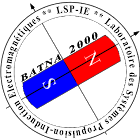, “High Efficiency Induction Motor Drives Using Type-2 Fuzzy Logic,” The European Physical Journal Plus, vol. 133, no. 3, 2018.
Publication Internationale
, “Higher Order Sliding Mode Control for Blood Glucose Regulation of Type 1 Diabetic Patients,” International Journal of System Dynamics Applications (IJSDA), vol. 7, no. 1, pp. 65-84, 2018.
, “Novel Speed and Current Sensor FDI Schemes with an Improved AFTC for Induction Motor Drives,” Advances in Electrical and Electronic Engineering , vol. 16, pp. 1–14, 2018.
, “Quantitative consequence analysis using Sedov-Taylor blast wave model. Part II: Case study in an Algerian gas industry,” Process Safety and Environmental Protection, DOI: 10.1016/j.psep.2018.02.003., 2018.
, “Quantitative consequence analysis using Sedov-Taylor blast wave model. Part I: Model description and validation,” Process Safety and Environmental Protection, DOI: 10.1016/j.psep.2018.02.002., no. 10.1016, pp. 116, 2018.
, “New Sensorless Speed Control of IPMSM Based on Backstepping Observer,” J. Automation & Systems Engineering , vol. 11 N°3, pp. 230-243, 2017.
, “A Neural and Fuzzy Logic Based Control Scheme for a Shunt Active Power Filter,” Springer edition. Book Title: Recent Advances in Electrical Engineering and Control Applications. , pp. 201-211, 2017.
, “A Neural and Fuzzy Logic Based Control Scheme for a Shunt Active Power Filter,” Recent Advances in Electrical Engineering and Control Applications, pp. 201-211, 2017.Abstract
, “Optimal energy control of a PV-fuel cell hybrid system,” International Journal of Hydrogen Energy, vol. 42, no. 2, pp. 1456-1465, 2017.Abstract
, “Degradation and performance evaluation of PV module in desert climate conditions with estimate uncertainty in measuring,” Serbian Journal of Electrical Engineering, vol. 14, no. 2, pp. 277-299, 2017.Abstract
, “Experimental investigation of effects of partial shading and faults on photovoltaic modules performances,” Leonardo Electronic Journal of Practices and Technologies, no. 31, pp. 183-200, 2017.Abstract
, “Real-time integration of control strategies for an isolated DFIG-based WECS,” The European Physical Journal Plus , vol. 132, no. 8, pp. 334, 2017.
, “Implementation and comparative study of control strategies for an isolated DFIG based WECS,” vol. 132, no. 10, pp. 415, 2017.Abstract
, “Sliding mode control of grid connected brushless doubly fed induction generator driven by wind turbine in variable speed,” International Journal of System Assurance Engineering and Management, vol. 8, no. 2, pp. 788-798, 2017.Abstract
, “Speed Sensor Faults Diagnosis in an Induction Motor Vector Controlled Drive,” Acta Electrotechnica et Informatica , vol. 17, pp. 49–51., 2017.
